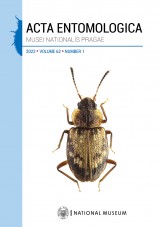Morphology of the larvae and biology of the adults of Psilorrhynchus bifasciatus do not confirm previous hypotheses about systematics and feeding habits (Coleoptera: Cantharidae)
Biffi Garbriel, Migliore Letizia J., Casari Sônia A.
Acta Entomologica Musei Nationalis Pragae 62(1): 23-34, 2022
Published online: 23rd April 2022
Views: 1940
Abstract: Psilorrhynchus bifasciatus (Blanchard, 1844) is broadly distributed through
South America, but its biology, behaviour and life cycle are unknown. The most
characteristic feature of the adults is slender rostrum, presumably associated
to a specialised feeding habit. However, new observations of P. bifasciatus
feeding on nectar in inflorescences of Matayba guianensis Aubl. (Sapindaceae) do
not support such a hypothesis. Here, we describe and illustrate their early
larval instars in details and compare them with the other Chauliognathini. The
larvae are remarkably characterised especially by a long and thick pubescence,
conspicuous roughness on the head and thoracic terga, and head with sharp
lateral projections. These features are unique amongst the known Cantharidae
larvae and do not confirm a previous hypothesis of close affinity between
Psilorrhynchus Gemminger & Harold, 1869 and bromeliad-inhabiting
Chauliognathini species.
Key words: Coleoptera, Cantharidae, Chauliognathinae, Chauliognathini, behaviour, biology, flower visitor, immatures, Matayba guianensis, Brazil, Neotropical Region
Papers
This issue is dedicated to Aleš SmetanaNew and little-known species of the genus Dicerapanorpa from northwestern Yunnan, China (Mecoptera: Panorpidae)A new Copelatus with small eyes from the Eastern Cape Wild Coast, South Africa (Coleoptera: Dytiscidae)Morphology of the larvae and biology of the adults of Psilorrhynchus bifasciatus do not confirm previous hypotheses about systematics and feeding habits (Coleoptera: Cantharidae)Review of the genera Elaphinis and Parelaphinis (Coleoptera: Scarabaeidae: Cetoniinae) with description of three new species from South AfricaThe ̒first fossil tumbling flower beetle’ larva is a symphytan (Hymenoptera)Revision of the genera of Picrotini (Coleoptera: Cryptophagidae: Cryptophaginae)First record of the genera Bulborhodopis and Mimapatelarthron from China, with description of one new species (Coleoptera: Cerambycidae)Two new species of the genus Omoplax (Hemiptera: Heteroptera: Tingidae) from Mukojima Island, with new records of lace bugs endemic to the Ogasawara Islands, JapanDiscovery of mysterious Pakistatyrus in Tibet (Coleoptera: Staphylinidae: Pselaphinae)Taxonomy of the intertidal athetine genus Eubadura stat. nov. (Coleoptera: Staphylinidae: Aleocharinae) from Japan, with descriptions of two new speciesTaxonomic notes on the Indian assassin bug Ectomocoris simulans (Hemiptera: Heteroptera: Reduviidae) with two new synonymsLeiodidae (Coleoptera) of the Hainan Island with new faunistic records from China and with notes on the unique body modifications in the genus AgathidiumA review of the genus Psammocrуptus (Coleoptera: Tenebrionidae: Tentyriini)Two new species of Xenos (Strepsiptera: Xenidae), parasites of social wasps of the genus Mischocyttarus (Hymenoptera: Vespidae) in the New WorldMorphology of larvae and pupae of the genus Autocrates (Coleoptera: Trictenotomidae) and its phylogenetic implicationsDrymini of Madagascar, with description of a new genus and three new species (Hemiptera: Heteroptera: Rhyparochromidae)Revision of Quedius sensu stricto (Coleoptera: Staphylinidae) 